
If you drive on 80 East toward the Bay Bridge in San Francisco, you can’t miss the “Greetings from Segment, the #1 CDP” billboard, with its illuminated 3-dimensional design. It’s more than a sign, actually — it represents a pre-2000s era, before the city banned new billboards with lights. Driving past, you’d never guess there’s a complicated story behind it.
As Maya Spivak — Segment’s former head of global brand — explains, the billboard was ripe for a design refresh in 2020. “We had a seven-figure, three-year contract for the billboard space,” Maya says. After two years of one creative, the team decided to pull the trigger on a re-skinning. Right when the ink was drying on that contract, Segment was acquired by Twilio for $3.2 billion. Before the acquisition news, she had hoped to keep the process as tight as possible to minimize the number of days that the board needed to be a blank slate.
“Don’t get me wrong, the acquisition was so exciting,” Maya says in retrospect. “But we wondered, Will the billboard information still be accurate? Will the publicly traded company that’s acquiring Segment care? Yeah, they’ll absolutely care, and we’d better get it right. Nothing can go live that would mess up the deal by something so trivial as a billboard in San Francisco, albeit a very special one.” In the end, the redesign was scrapped entirely in favor of a slight refresh that placed the Twilio logo in its new rightful place as the owner of Segment’s brand.
In hindsight, Maya describes the experience as “funny,” but it was anything but at the time. Such is the life of a tech marketer who specializes in building brands from the ground up for fast-growing startups. “My true love is growing tech brands from very early days, like sub-10 people on a team, all the way up to hundreds of millions of dollars in ARR,” Maya says with a huge smile.
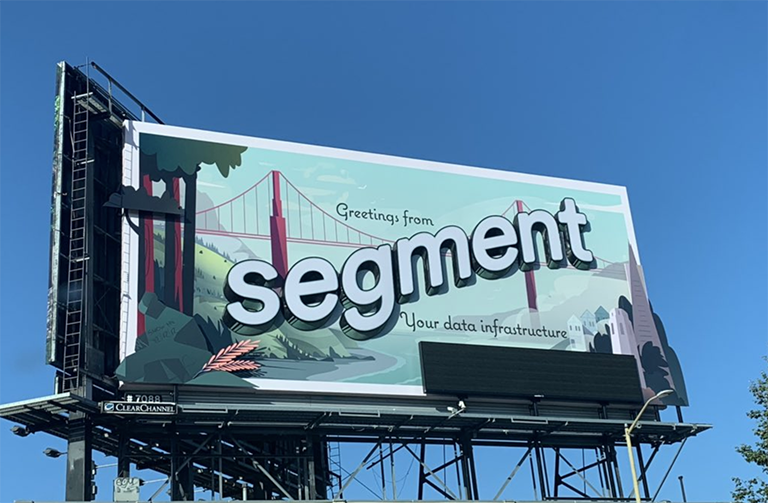
With nearly 15 years of experience helping to write some of Silicon Valley’s brightest startup stories, Maya is now working independently with tech founders, VCs, and marketing leaders. Before going out on her own, she led marketing for Gretel, the synthetic data platform powered by generative AI, and Mux, the video infrastructure company, both times from the exec team. Maya’s tech career started at Wildfire (a social media SaaS company acquired by Google in 2012), then grew into marketing leadership at Wealthfront, where she joined when there were just 24 people.
Ever thought about giving raw feedback to a company you admire? Call it risky, but it worked well for Maya — she even got a job out of it. In 2009, Maya was an opinionated early user of Wealthfront’s. “I was a deeply enthusiastic customer and enjoyed walking past the office in Palo Alto every day.” Maya considered the company’s window sign — a simple piece of styrofoam board — an eyesore, so she contacted them to say, “The piece of paper with your name on it is not great to engender trust for sophisticated investment services.”
Wealthfront thanked Maya for her honesty. “I became that woman — if you were generous you could say I was consulting for free,” she says. Her unsolicited feedback ignited a friendly relationship for about a year: “I became close to Wealthfront by being a real, live alpha user who told the truth because they weren’t paying me. … Then when a marketing role opened, they asked me to join and I said, ‘Heck yes!’ because I love the product. I still love it.”

Maya kept her Wealthfront experience of being a “cult-like” follower close to her vest. As her career has ascended, “evangelism” continues to be a key tenet — in fact, her title at Wildfire was “Chief Evangelist.”
“Evangelism is a beautiful euphemism for a type of sales that’s one to many,” Maya says. “It’s a person whose job is to proselytize, like a religious leader. You try to recruit people to your cult. The most successful folks who recruit others to their cult are the ones who are the most passionate about it. You can smell that from a mile away.”
Maya says the difference between a “snake oil salesperson” and a genuinely excellent salesperson is in their ability to make people believe because they believe. “Of course, everyone’s selling incredible products that are so cool. Everyone’s product is more technologically advanced than the next guy,” she says with a wink.
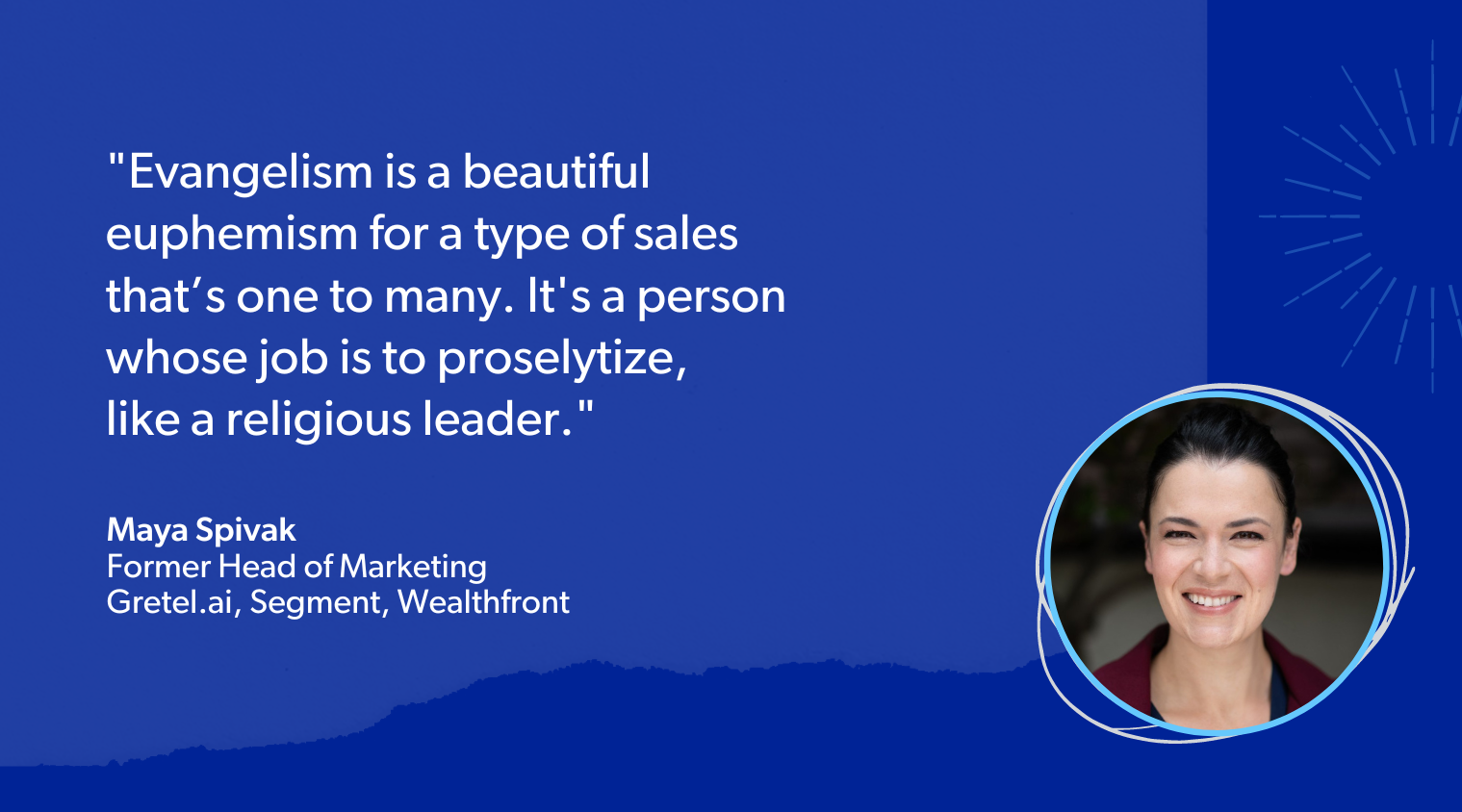
Evangelizing, she says, requires putting your all into the delivery, especially in the technical practitioner space. “Entire teams are built around evangelism — they’re called developer advocacy, developer evangelists. That’s where it’s A-OK to be proselytizing. Nobody calls it that but that’s what’s happening.” As she sees it, this is the natural evolution of tech marketing, highlighting the last couple of waves of developer brand growth with Twilio, Docker, and big tech brands like MongoDB. “They grow through their communities, people who raise their hands and say, ‘I’m a lover of this product, and I’m going to evangelize on its behalf.’ These people are called advocates and evangelists and they’re technical practitioners.”
At the end of the day, Maya believes the new wave of tech marketing is still about selling and convincing others to get on board. “It’s a tale as old as time,” she says. “For as long as you’ve had somebody telling a story and recruiting new followers, that’s what we do — now it’s called developer advocacy. ‘Use my language. My language is superior to this language. This is the framework you want to use.’ It’s different types of religions and philosophies, but the motion is the same.”
In this edition of Bright And Early, Maya talks about helping to build CrunchBase as a college student, knowing when it’s time to leave a startup, and overcoming guilt of being an “energetic startup type.”
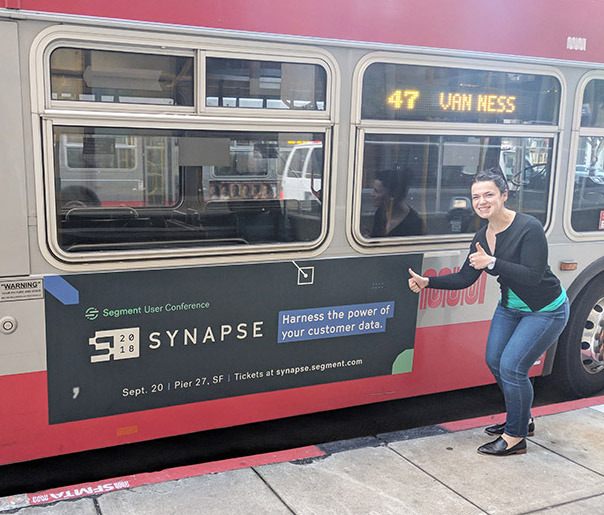
Maya Spivak: I tried to set myself on the journey while I was still in college. I worked remotely for TechCrunch, the year CrunchBase was born. CrunchBase started way before the massive Wikipedia of information that’s tech-specific that we know it to be now. It was born of Mike Arrington’s head — he was the founder of TechCrunch before selling it to AOL. The year that CrunchBase was about to debut, he’d hired college students across the country to write the seed entries. Before class, I would log into the CMS and go through the list of what the writers were committed to writing about that week. I would take this branching path of research, and, for example, I would be researching a company called Uber Taxi and then write a paragraph about that. And if I had time left, I would branch off to Travis Kalanick, and if I still had time left, I would branch off to Benchmark Capital, who led the first round, and so on and so forth. I did this for a year.
You can pattern-match all the stuff that I was writing about — the coolest, most interesting ideas were being born in Silicon Valley — and I’m from Queens, New York. I knew I needed to move to this place to be where tech was born and be a part of the community. I set my sights on “go west, young man.” Young (wo)man. That was me.
Maya: Wildfire was really a formative experience in my life, and I just feel so lucky as I reflect on everything that it’s done for me. I was employee number seven. I started in late 2009, early 2010. In those days, we had a little office on El Camino Real between Palo Alto and Mountain View. So for anybody who knows those two areas, those two areas are like small cities. But being on El Camino Real between those two small cities is basically like being in the middle of nowhere. We didn’t have a kitchen, so we brought our own lunch and I washed my Tupperware in the bathroom.
As an early marketer I was hired to focus on social media. The reason it could be so formative and that working startup years is like working dog years is because I could do all my social media for the day, but then I have to fill in the rest of those gaps of time with customer support. Over time, I managed a customer support team. There were more of us than could fit into this 15-person office, so I managed our move to a second office downstairs, right next door to a Mexican bodega. I became an expert in data cabling, and I know all about CAT-5 and CAT-5E wires and AT&T and fiber optics because I was physically doing that. There was a woman, Rachel Mozenter, who’s now an incredible enterprise sales leader. She was an intern at Wildfire while she was still at Stanford. I took Rachel with me to Ikea on her first day interning. That’s what working at a very early-stage startup is like. You have to do all the things and you do it because it’s what’s necessary at the time.
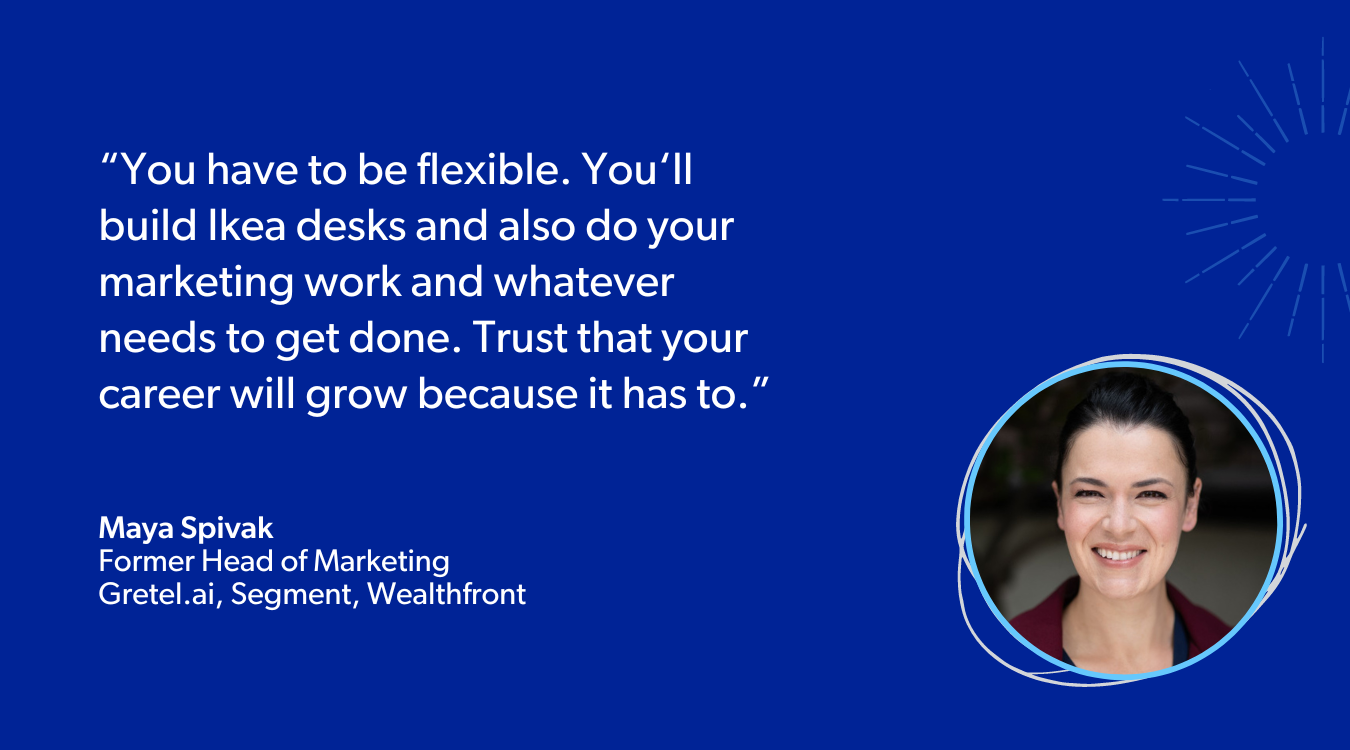
You have to be flexible, enjoy the people, and you’ll get down on the floor and build Ikea desks and also do your marketing work and whatever else needs to get done. Trust that your career will grow because it has to. At some point, there were enough of us that I had to make a choice. Did I want to run customer support or do marketing? Customer support came with a team and I could be a people manager. So cool, right? I wasn’t going to manage any people in marketing, but I could do this thing that I found so much joy in and so that’s the first time in my career that I had to choose. I chose marketing.
Maya: It maybe didn’t make me a better marketer, but it did make me a lifetime startup enthusiast. We were so flexible and pulled in so many directions. Most people who thrive in that early startup environment are people who are, by nature, very resilient, very open-minded. They stay calm in an ambiguous environment. They’re willing to put on different hats and don’t see it as a threat to their personal or career development. They’re not super resistant to change and they thrive in an environment that’s slightly chaotic and incredibly fast-paced. That experience and the friends I made who stayed with me till the end, those people are the closest folks in my life now and solidified that startups are where I want to be. These are the kind of people I want to surround myself with all the time.
Maya: No, it’s not always the same. I learn more things and internalize them into the process and then I can see my own reactions changing. As a person with a more adult brain than I had when I was 22 and working at Wildfire … There’s this incredible research that shows that a brain is not mature until it’s 25 years old. At 25 on average is when you have a mature adult brain. That’s why you can’t rent a rental car under 24, right? You’re too much of a risk taker.
So I was in a different headspace and choosing differently when I was that young versus the headspace that I’m in now and the life that I have around me now. Some of that actually really does paint my choices.
If I’m talking to a new founder or we’re doing a bit of advising or consulting, what’s the cadence with which they send messages or notes? Is it Saturday morning or Friday night? Those are mini signals that are part of a greater picture that I wouldn’t have paid attention to and didn’t frankly care about when I was 22. But I care a lot more about now, given the benefit of time and experience.
Maya: They were super different. At Wildfire and then at Segment after Wealthfront, I was selling B to B. At Wealthfront, yes, we were selling B to C, but we weren’t just selling anything — we were selling sophisticated financial services. I continue to use the word “sophisticated” because financial services in and of themselves, generally as a category, could mean so many things, but they could be non-sophisticated, like a credit card. Financial services is very intimidating and we were selling an investment product with a long time horizon. Even using the word “horizon” when you’re talking about financial services implies that the whole thing is a very complicated situation.
We had to sell sophisticated financial services to consumers directly in a way that wasn’t really done before. Like this Robo Advisor situation, relatively brand-spanking-new with Wealthfront, much of my marketing work was product marketing. My entire job was creating content. And it had to be high production value, trustworthy, and no gimmicks because you have to engender trust — this is a lot of money for a lot of people.
At the time, the minimum investment a customer could make was $5,000. They had to have $5,000 that they were ready to kind of lock up, throw away the key, and essentially forget about for five years or so. That was the recommended timeline for a lot of people. That was not the case for a lot of mainstream consumers, that they were comfortable with that at the outset.
Maya: At Wealthfront, it meant figuring out how to scale our growth directly to consumers. From the very beginning stages, we were really popular with a certain ideal customer profile, the ICP. The ICP was engineers and tech people, most were in Silicon Valley or New York City. In 2012, this is what it was.
At some point, you hit critical mass and have to expand beyond those people, beyond engineers. The journey to figure out how to do that was really exciting at Wealthfront. In 2015, we spent the entire year trying new channels, including television. I have my still abiding love for telling stories with video because we put 35 commercials on TV. TV is a medium I never thought I’d play in unless I had stayed at Google or a very large company. I didn’t think I would have that opportunity at a sub-100 person startup. Wealthfront was only 24 people when I joined, and still around 100 people when we put 35 commercials on the air nationally. I felt so lucky! You get to do some really exciting stuff when you work at startups.
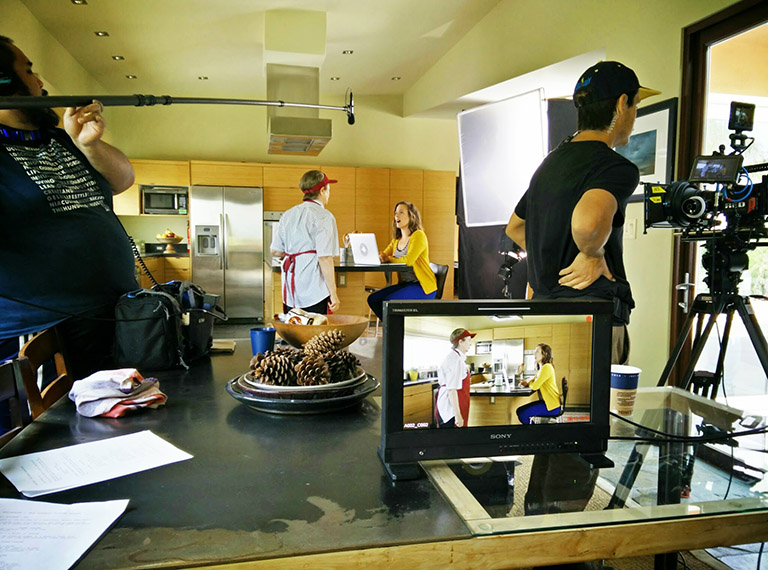
Maya: I encourage people to really think about what’s important to them in their own career growth, and the tradeoffs — the things that make them tick and are must-haves as opposed to nice-to-haves. At Wildfire, I spent so much time on a stage, advocating for people to do something. I traveled all over the place, teaching social media marketing — which is so funny now because who was teaching social media marketing at the time? People needed to be taught, and I adored that. Then I went to Wealthfront and couldn’t wait to be on a stage teaching people about personal finance and long-term passive investing. But I quickly realized that when selling financial services, especially selling sophisticated financial services, nobody needs to hear from a marketer.
Put yourself in the audience. Who do you want to hear from? There’s a lot of scenarios in which you as an audience member do not feel like you can trust or want to be sold to by a marketer or a salesperson. If you’re in a selling conversation and need to be sold something, it has to be clear that you’re in a selling conversation and you’re being sold something. You’ve entered into that consensually and everyone’s happy with that. But every other place that you might be where you’re watching someone and you’re expecting to be taught something and you’re going to walk away better educated than you were before, you’re going to think, “Wow, those people had credibility and expertise.”
Who are the people you’re trying to listen to? They’re the technologists, the builders, the person who is hands-on, built the whole thing and has an opinion about why it was built that way. Or they’re the customer-facing specialist in that product. Oftentimes it’s not a salesperson or a marketer and that’s probably because you’re selling a sales tool or you’re selling a marketing tool and it’s OK, you are the expert, but that’s not typical.
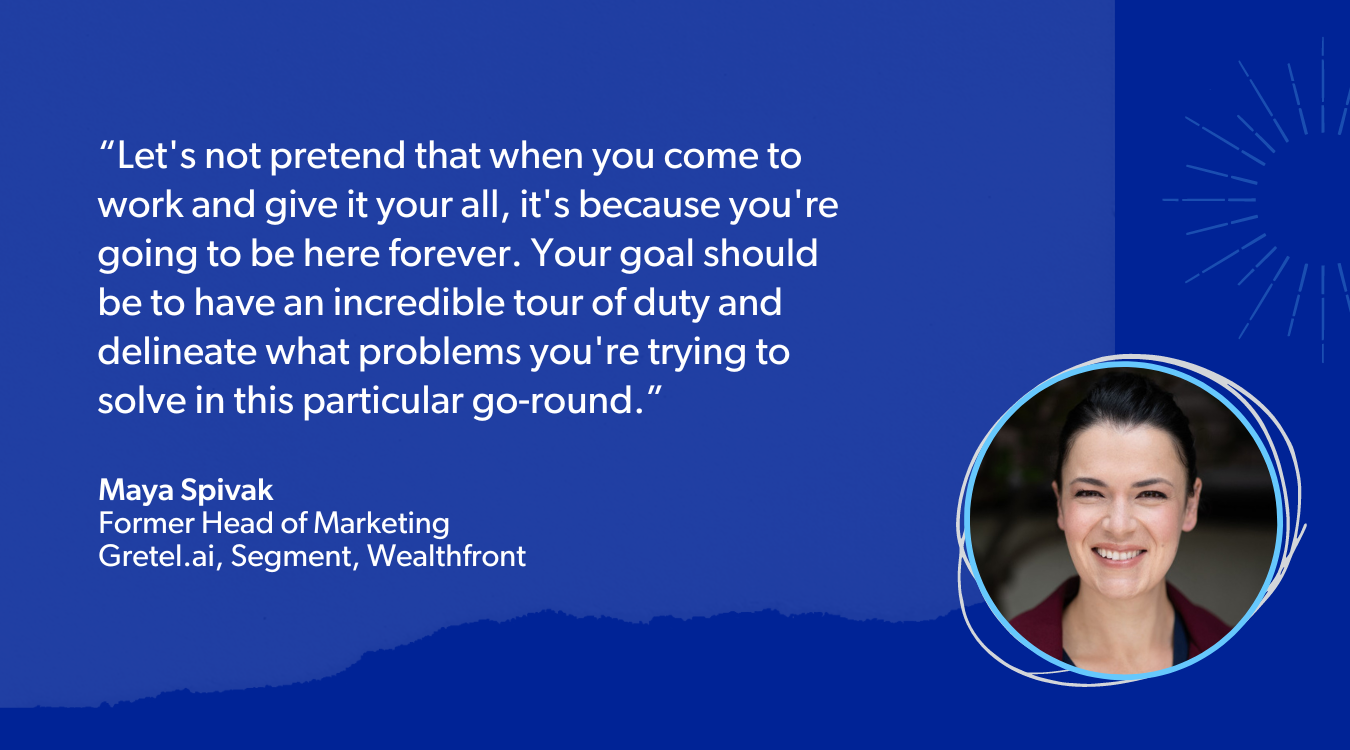
Maya: It’s different for everybody. I learned this at Wealthfront and from Andy Rachleff, who is probably the number-one leader I’ve ever had the privilege of working with. He enlightened me to the idea of a tour of duty. He’s the first person I heard not just say out loud, but really live the idea that this is not your last job. Let’s not pretend that when you come to work and give it your all, you’re giving it your all because you’re going to be here forever. That shouldn’t be your goal. Your goal should be to have an incredible tour of duty and delineate what problems you’re trying to solve in this particular go-round, this role that you were hired into.
Figure out what the problem is. Solve it. Typically, it takes a couple of years in startup land. Things move so fast that within a couple of years, the entire company looks different. There’s been a lot of churn, either outside or inside. Either way, the world has effectively changed and things are upside-down now. Does your role still make sense? Does your team still make sense? Does the product still make sense? Is there a new challenge for you to work on? Or are you stuck on the same thing?
There will be points where it should be very clear that you’ve done the thing you said you would do and that they needed you to do. And there’s a new problem here. The next thing that you can do here is this other thing. You really should talk with your manager and be like, “now we’re this kind of company selling this kind of service, and it’s completely different. I’m going to tackle that now.” You very mindfully go into your next tour of duty, and could have multiple tours of duty in one place, or you could have just one and then be like, you know what? I did what I came here to do. The company’s completely different. Now it’s probably time for me to find another tour of duty somewhere else that I could be more useful with my particular skill set.
Andy Rachleff was the first leader who said, “Thank you for doing everything you did for us. He was just so human and gracious about it. I have not seen that everywhere. That’s not the norm.”
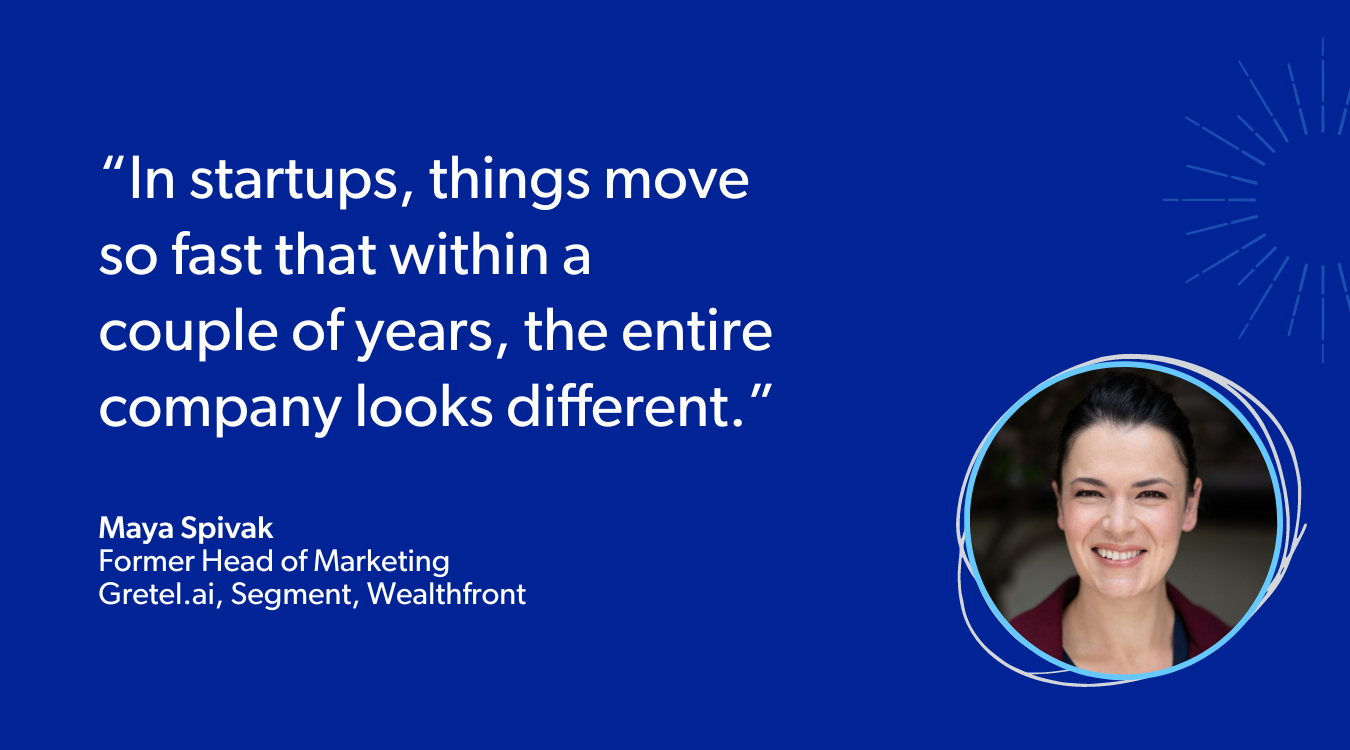
Maya: I’ve recruited a number of people who weren’t from the startup world and then got them hooked. I think the traits I look for are the sense of that resilience and desire to be really engaged and passionate about something. That’s the platonic ideal of a hire — they’re super engaged and passionate about something and you could bring them in from the outside world. But then there’s also recruiting people who you just know are very good at what they do and have a particular skill set.
It would be a gift to your own organization if you could get them over to your side. In particular, I’ve recruited people from big companies that are particularly good at planning, organization, program and project management, which is one of the things that is managed very poorly at a lot of startups. It’s pretty typical. I guess it’s because this is the kind of person you tend to recruit is like someone who is excitable and enthusiastic, and that leads them into slightly chaotic way of operation. And that’s OK. These are skill sets that match really beautifully. That’s me. I’ve just described myself: extremely excitable, very enthusiastic, fast-moving, action-oriented, not very organized. It’s not my specialty area. I felt so much guilt about that for so long. I felt like I had to really get my shit together, practice spreadsheets, and do well with swim-lane diagrams. All stuff I had to do in my first job, at IBM, which demanded a certain level of organization and rigor. Which was probably part of the reason I was deeply dissatisfied with that experience.
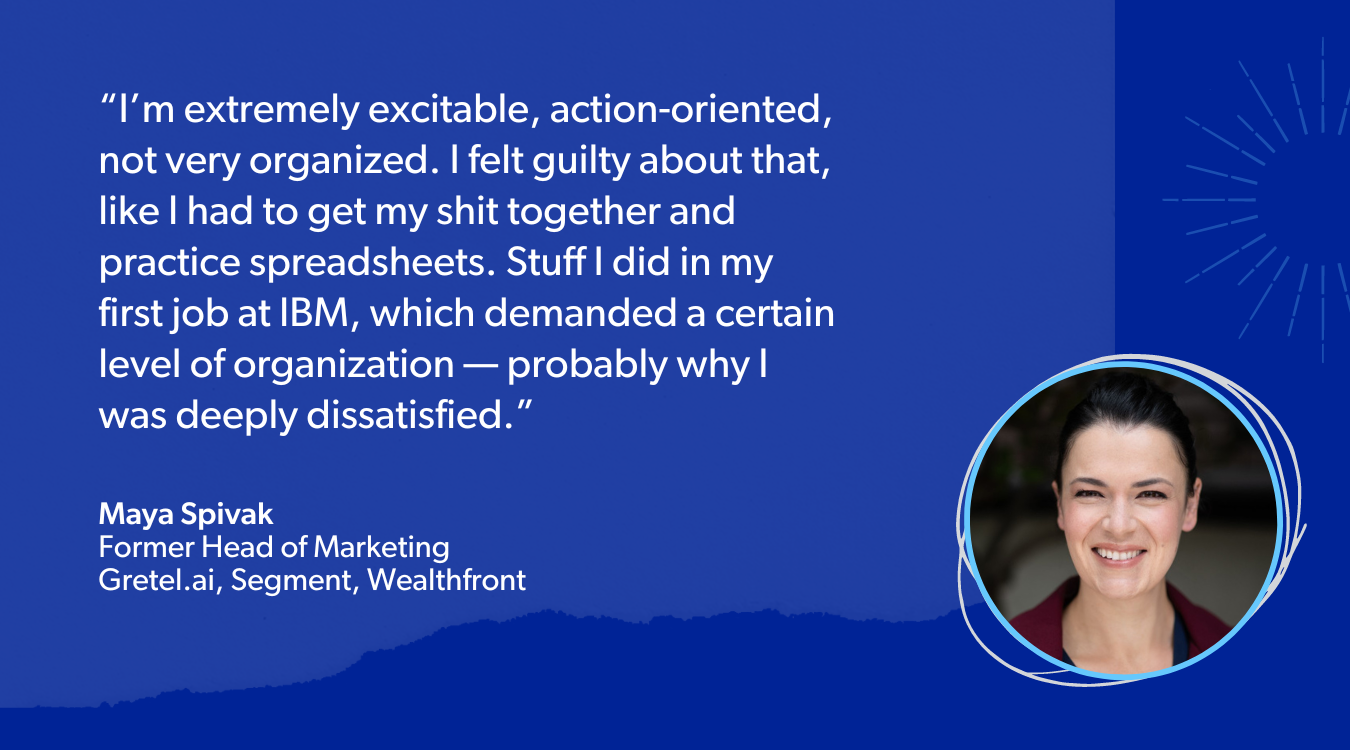
You have to understand who you are and that early startup success is probably having a lot to do with that. All of us in a room together means hectic chaos. Hiring people who can complement that and bring a level of organization and streamlined thinking, charts, and maps, oh my goodness. It can be a game-changer. I’ve hired people where I tell them that about themselves and I’m always very honest about myself. I’m like, “you’re going to come help me because I’m terrible at these things. But I know that you’re incredible at these things.” No one has quit on me yet.
Maya: Definitely a sports team.
Maya: What does the team need? What do we need next? I believe in the importance of which hires to prioritize, especially in this environment where money is not free and you have to fight for every last penny, and really make a case for headcount. Now you have to make like three times the case for headcount and write all these essays about justifying one headcount. And if you have to be so mindful of one hire at a time, it really helps to figure out the order that’s most important because the next one is not coming for a while thereafter, right? So the order in which you prioritize really matters. Now you have to think about, “Am I going to spend a hire on project management, program management?” And the answer should be yes some of the time. And really taking the time to be introspective about, are we at this stage yet? It could be yes. You’d be surprised how much it brings to your team and to your company at large. It’ll just change the game as far as communications and productivity.
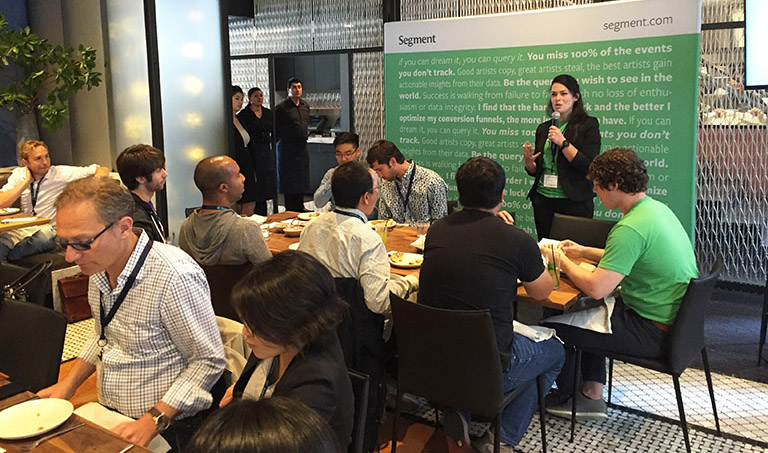
Maya: You really have to spend a lot of time with the different components of a sales org, and those also grow over time. You could start with a small marketing team. You start with a small sales org. At that point in time, it’s really easy to know every single person. It’s easy to know what they’re good at if you put in a little bit of that time. But then as it grows and starts to scale out and you have sales orgs that have component parts that you’ve never even heard of, right? They’re making sure everyone has the same definition of what is commercial, versus mid-market, for what territories, who does this? What is the inbound flow? How do we do outbound?
Don’t assume anybody knows anything, and spend as much time as possible getting to know the people. Not all people are alike, so not all salespeople have the same exact skills you have. Some are a lot more technical than others. Some of them want to speak on a stage or “man” a booth. They want to hustle the floor. Other people prefer to do their outreach at their desk, like inside sales. They orient themselves in a specific way according to who they are. We don’t treat them that way unless we’re being very mindful about ‘how are we going to enable this organization to sell?’
I have a handful of people here who want to pound the pavement. Let’s put them out there at marketing events. Let’s build entire marketing events for them. This is field marketing. And then you have these other folks who are like, “Can you run a couple of campaigns for me to feed me leads that I never have to exit my house?” And that’s OK too. This requires working closely with your sales leader and the actual folks doing the thing. It’s about understanding who they are, what they’re capable of.
Meetups are off the charts in terms of human bodies packing it in and trying to learn about these tech products. People have enthusiasm now to listen to your pitch. My job as a marketer at a physical event is to count bodies, and then to take them down one by one still. Even though I’m not on a stage, I’m trying to make my message come across to as many people as humanly possible. When I’m at these events and in the community — and I live in San Francisco, so I’m just in the heart of it, which is what I always wanted, right? Like… I did it. Look, Ma, I made it.
That’s what’s bringing me so much energy right now — we’re in this magic moment where events are back and people love them. We’re not jaded about them anymore. It’s not like a “San Francisco yes” anymore. It’s like, holy moly. Let’s go to the event. And I’m excited to capitalize on that as a marketer.
How Pinterest’s Head of Product knitted a ‘collaborative breakthrough’ culture
Kickstarter to global ascent: Peloton’s first biz dev leader on building from the ground up